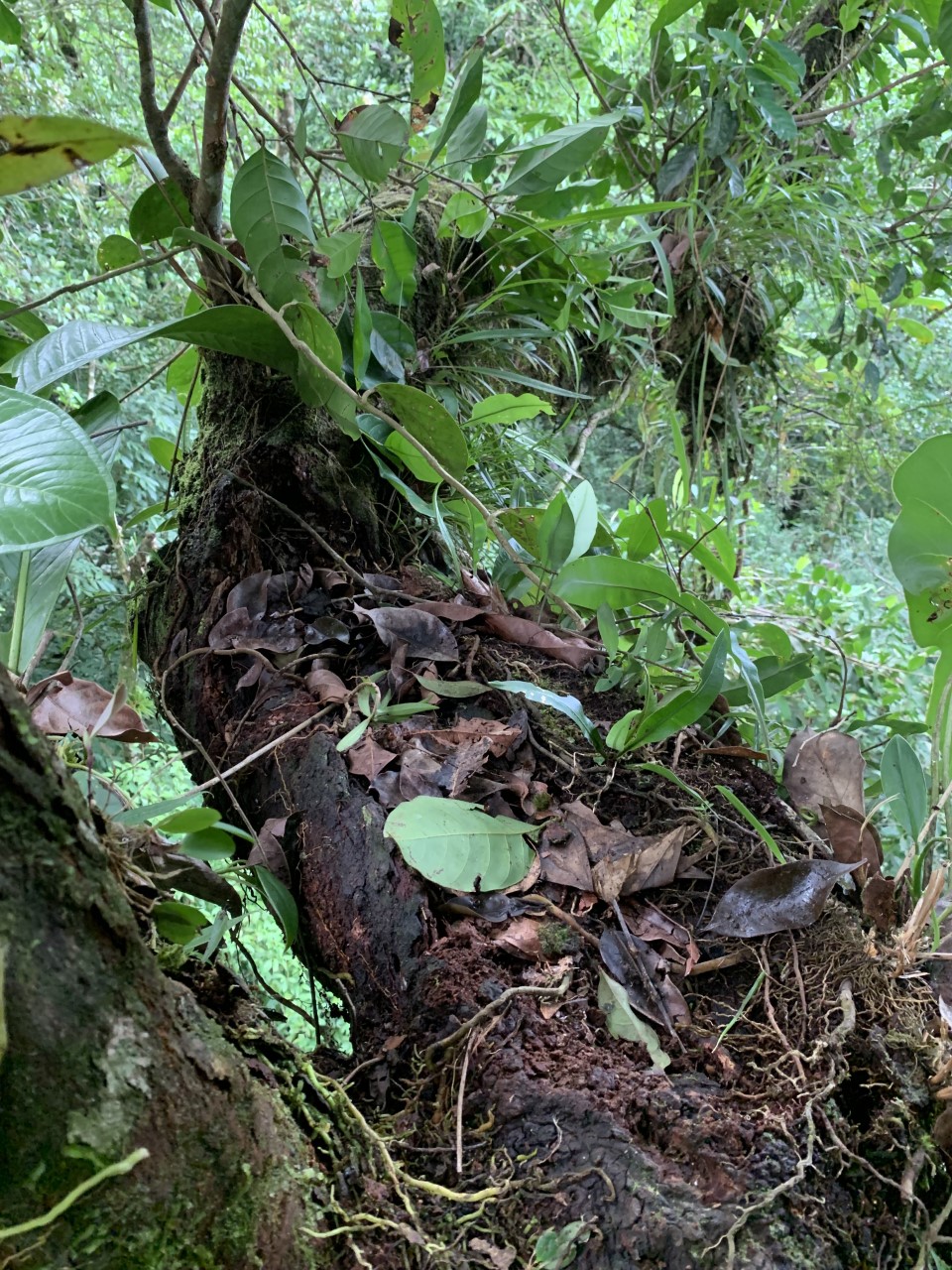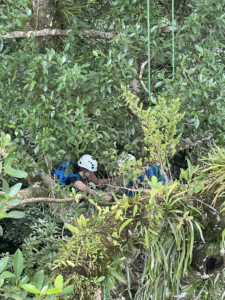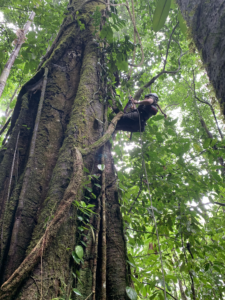Canopy soils that form on tree branches contain three times more carbon than soils on the ground in Costa Rica, potentially serving as an important carbon sink around the world
14 December 2021

Organic soil formed from epiphyte mats on a tree branch in a tropical humid lower montane rainforest at the Texas A&M University Soltis Center for Research and Education, Costa Rica.
Credit: H. Connuck
AGU press contact:
Rebecca Dzombak, +1 (202) 777-7492, [email protected] (UTC-4 hours)
Contact information for the researchers:
Peyton Smith, Texas A&M University, [email protected] (UTC-6 hours)
Hannah Connuck, Franklin and Marshall College, [email protected] (UTC-4 hours)
NEW ORLEANS—New research reveals a previously underappreciated way old-growth forests have been recycling and storing carbon: treetop soils. Branches in forest canopies can hold caches of soil that may store substantially more carbon than soils on the ground beneath them, and scientists are just beginning to understand how much carbon canopy soils — which exist on every continent except Antarctica — could store.
The new research on these unique soils, being presented on Wednesday, 15 December at 5:00 p.m. CST at AGU Fall Meeting 2021, marks the first attempt to quantify carbon capture by canopy soils. The work highlights another way old-growth forests are rich, complex ecosystems that cannot be quickly replaced by replanting forests.
Tree branches collect fallen tree leaves and other organic material over hundreds of years, like the ground does. On top of the branches, the plant litter decomposes as it accumulates, forming a carbon-rich layer that can be several inches thick. The researchers climbed up into the rainforest canopy in Costa Rica, instruments in hand, to find out just how much carbon canopy soils can contain.
Active carbon, a short-term storage pool of organic carbon, was three times higher in canopy soil compared to soils underfoot, the researchers found.
“We knew these would be really organic-rich soils, but we didn’t expect the extremely large amount of carbon compared to mineral soils,” said Hannah Connuck, an undergraduate researcher at Franklin and Marshall College who will be presenting the study results.

At 30 m height above the ground, Hannah Connuck collects canopy soil for carbon measurements from a humid lower montane rainforest.
Credit: K. Munoz Elizondo
The researchers are still calculating the total concentration of organic carbon at their research site, but other research has found canopy soils to have up to 10 times higher concentrations of organic carbon, according to soil scientist Peyton Smith, a study co-author and Connuck’s soil science mentor at Texas A&M University.
Connuck and Smith also measured how much carbon dioxide was being released by microbial organisms living in the canopy soils, which is critical for knowing whether soils are storing or releasing carbon overall. They found that even though the microbes were releasing higher volumes of carbon dioxide than ground soils, their rate of carbon storage was rapid enough to compensate, likely making canopy soils a net carbon sink that has not been considered in carbon models yet.
“It could be a substantial carbon sink, and we need to account for it,” Smith said.
Like other soils, canopy soils take a long time to form, and therefore take a long time for a forest to recover if an area of old-growth is cut down. The soils also host unique microbiomes, including highly diverse microbial organisms and canopy-specific plants like epiphytic orchids.
“It’s a good argument for keeping primary and other old-growth forests around, rather than harvesting and replanting with secondary growth forests,” Connuck said.

Peyton Smith, lead researcher, climbs high to study canopy soils at the Texas A&M University Soltis Center for Research and Education, Costa Rica.
Credit: H. Connuck
###
AGU (www.agu.org) supports 130,000 enthusiasts to experts worldwide in Earth and space sciences. Through broad and inclusive partnerships, we advance discovery and solution science that accelerate knowledge and create solutions that are ethical, unbiased and respectful of communities and their values. Our programs include serving as a scholarly publisher, convening virtual and in-person events and providing career support. We live our values in everything we do, such as our net zero energy renovated building in Washington, D.C. and our Ethics and Equity Center, which fosters a diverse and inclusive geoscience community to ensure responsible conduct.
Notes for Journalists
Hannah Connuck will present the results of this work at AGU Fall Meeting 2021. For information about Fall Meeting 2021, including the schedule of press events, visit the online Media Center. Neither the presentation nor this press release is under embargo.
Presentation abstract:
B35B-1436 – Canopy soil capture: An overlooked source or sink of carbon in humid tropical forests?
Wednesday, 15 December 2021, 14:00 – 16:00 CST
Session information:
B35B – Tropical mountains and forests: Connections in a complex, changing world I Poster